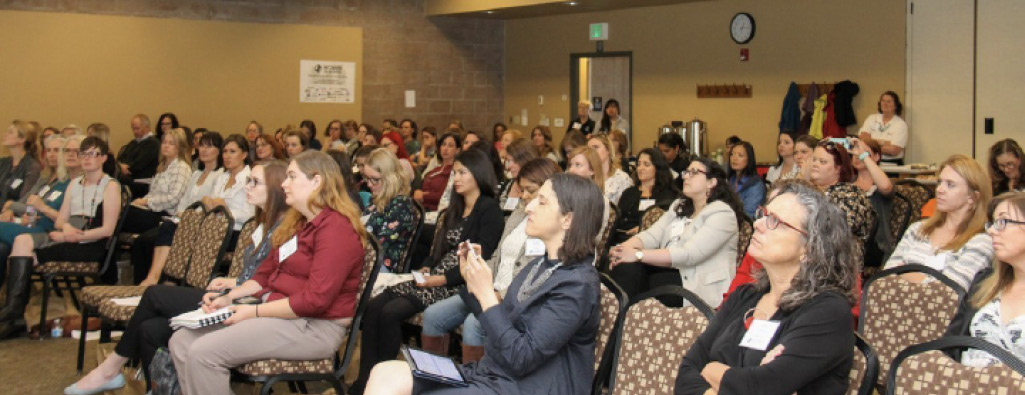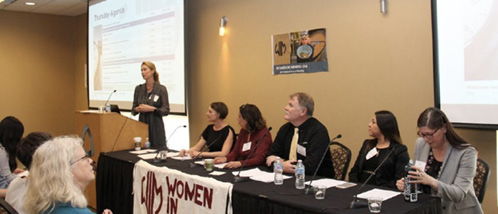As It Nears Its 50th Anniversary, Women In Mining USA Proves Its Members Are No Pushovers When It Comes To Their Places In The Mining Industry – They’re Grabbing The Reins And Holding On For The Long Haul.
By Donna Schmidt
There is no one more aware of mining’s history as a male-dominated industry than those who are not part of the majority. There is an evolution abound, however, with women firmly taking their seat at the some of the biggest and most future-altering desks in mining.
From its start in 1972 in Denver, Colo., Women in Mining has had a long-standing commitment to supporting women regardless of job position to get the most from their industry careers. The group has since grown into a diverse cross-section of geologists and engineers, accountants, surveyors, government personnel, lab techs, administrators and some of the top executives for global operators spanning six regional chapters and several student chapters across the nation’s top mining engineering universities.

A book club this is not. WIM USA, as it has come to also be known, consistently is advancing networking opportunities for its members as well as offering continued education and speakers offering crucial information on working more safely and efficiently – a long way from its start in the ’70s when some women were not even allowed to join the group’s ranks.
Today’s location-based chapters include Arizona, California, Denver, Nevada and Utah chapters as well as an at-large group for those without a nearby chapter. There are also several Women in Mining chapters in Canada as well as a newer group in Mexico. All aforementioned groups are partners with the International Women in Mining conglomerate to share information, research and networking opportunities with memberships in many other mining-rich regions worldwide.
In fact, since 2019, WIM USA broadened its mission to not just including women in its support, but to assisting diverse minorities in their careers – a nod to the changing times globally and mining’s prioritization of inclusion and diversity from every level of the industry.

“Diverse teams are more effective, efficient, and have higher productivity,” noted Anita Bertisen, who in addition to her leadership role with WIM also serves as Cripple Creek plant manager at Newmont’s Victor gold complex in Colorado. This is in addition to members’ abilities to successful educate the public of all ages on mining’s benefits and influence public perspective for an industry that has gotten less-than-fair treatment from outsiders’ lack of understanding.
WIM for the Future
With women firmly positioned to take their involvement in the industry skyward, there is a true vision for the future. This is evident in speaking to Bertisen as well as Amanda Adams, who is a mining principal for consulting and engineering group Stantec in its Denver office.
Why is the topic of women in mining important to you personally?
“I am incredibly passionate about women in STEM and have been involved with Women in Mining since 2010. I currently serve as the Denver chapter president. I love interacting with other women in the industry and I get so much personal fulfilment from seeing women succeed in the industry,” Adams said.
“Of course, 2020 was a huge challenge for our group and many planned activities were cancelled or delayed. However, we were able to effectively pivot to virtual presentations and workshops and actually added more members last year than in many years past.”
Did someone or something in particular get you involved in WIM?
Bertisen noted that it was her employer, Newmont, which ultimately led to her involvement in WIM. She rose through the ranks in her career and moved from site to site since beginning her career in 2001 in Tasmania, Australia. Much has changed in her 20 years, she noted; the push for women to “be a part of the gang” or to “man up” in the face of a challenge have evolved to a female force that builds bridges, breaks barriers and knows no boundaries.
If she can share one thing with others, it is to “be your true self,” she added.
For Adams, she hands thanks to her colleague Resa Furey for the introduction to WIM at the group’s national annual meeting in Denver in 2010.
“The speaker on the opening night was a historical re-enactment presenter. It was so much fun, and totally unexpected. I have been involved with WIM ever since,” she noted.
Why are women vital to the industry moving forward long-term? Do you believe WIM as a global group will be crucial to the movement of that barometer?
For Bertisen, vital is a key word, stressing that in many areas they are qualified and experienced to offer a perspective that a man cannot, be it the avenue to take to work more productively, building a dynamic team or being a more effective leader because of what they bring to the table.
As for being a barometer? “I hope so,” she said. “No one company can address this by themself…[but] this groups is here to be a catalyst.” For that success to be achieved, she noted, there must first be a critical group of women, which is being created right before our eyes.
“Companies are going to leverage WIM to do that,” she added.
Adams concurred. “Women are vital to the industry, and I think WIM is vital to showcase those women who are already in the industry.
“Before, you would never see women representing mining companies or projects. Now it is much more common to see that representation, and that makes it much easier for women and girls to consider the industry as a career path. By conscientiously endorsing women experts in the industry we will be able to attract future generations of women to continue, and improve, the overall mining field.”
As the two look back on their lengthy, multifaceted careers, both point out that they got into their careers more by accident than by some dictated design, and neither had seen their careers progress like they have before they reached this point.
“When I was starting out, I had no clue what a career in STEM meant and as an engineer I can honestly say that I do very little ‘hands on’ engineering; my background in STEM allows me to understand technical concepts and work with teams to solve incredibly complex technical problems,” Adams explained. “My role is almost entirely about communicating and teambuilding.
“My advice to anyone – women or men – entering the industry is: don’t discount the value of, and need for, well-rounded skills. The industry and employers need all of us to lead at every level of our careers.”
Join Women in Mining for their National Annual Conference
Oct. 21-23
Salt Lake City Marriott University Park
Salt Lake City, Utah 84108
For more information or to register, visit
www.womeninmining.us
